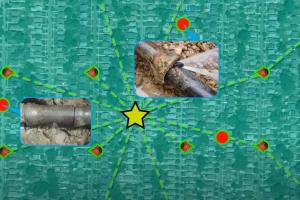Pipeline Assessment Technology Helps English Water Utility Love Every Drop
Keeping its network of more than 38000 km (or 22,000 miles) of water mains in working order is extremely important for Anglian Water. The utility serves the East of England, an area that is among the driest in the country, receiving only approximately 600 mm (23.6 in.) of rain each year on average—significantly less than elsewhere in England. In response to a projection of future significant population growth in the area, the utility evaluated 7.2 km (4.5 miles) of an existing line between a reservoir and a treatment facility to determine if it could stand up to increased stress.
Non-Invasive acoustic solution saves Anglian Water time and money
Keeping its network of more than 38000 km (or 22,000 miles) of water mains in working order is extremely important for Anglian Water. The utility serves the East of England, an area that is among the driest in the country, receiving only approximately 600 mm (23.6 in.) of rain each year on average—significantly less than elsewhere in England. With more than 6 million customers in the region and in Hartlepool, Anglian Water’s 27,500-sq-km (10,618-sq-mile) service area is the largest of any water and sewerage utility in England and Wales
“Some areas have a lower annual rainfall than Jerusalem,” said Fionn Boyle, Optimisation Project Engineer for Anglian Water. “That’s why it’s vital that we look after the water that we’ve got.”
Boyle said the region’s topography provides little assistance for the utility. “Large parts of our region are typically flat and low-lying, with approximately a quarter of the land actually below sea level,” said Boyle. “With few hills around to help out with gravity, Anglian Water has to rely on pumping water from place to place, and that uses lots of energy.” Boyle said the region’s topography provides little assistance for the utility. “Large parts of our region are typically flat and low-lying, with approximately a quarter of the land actually below sea level,” said Boyle. “With few hills around to help out with gravity, Anglian Water has to rely on pumping water from place to place, and that uses lots of energy.” This relative scarcity requires Anglian Water and its customers to do everything they can to make the most of the water they have—hence the utility’s slogan, “love every drop.”
Rising Demand
In response to a projection of future significant population growth in the area, the utility evaluated 7.2 km (4.5 miles) of an existing line between a reservoir and a treatment facility to determine if it could stand up to increased stress.
“The population of Anglian Water’s region is expected to grow by close to 20% by 2035, against a 2010 baseline,” said Joseph Finn of Mueller Water Products. “The existing system could not support the forecasted demand.”
To help alleviate demand on the existing pipeline, Anglian Water devised a plan to install an additional 7.2 km (4.5 miles) of water main between the reservoir and the plant. However, the utility also had to address problems with the pipe that was already in ground.
“There was a higher than average number of breaks on the existing pipe due to corrosive soil conditions,” Finn said. “This meant the main had to either be rehabilitated or replaced. Due to Anglian Water’s commitment to reduce its carbon footprint, rehabilitation was the selected route.”
While conducting the rehabilitation, Anglian Water discovered a 198-meter (650-ft) stretch of pipe that potentially could be exempted from the project if the utility could prove its condition was suitable for continued use. If this was the case, a costly and complicated rehabilitation could then be avoided.
“The section ran under an environmental protection area, where it was found to suddenly sink and rise in level on either side,” Finn said. “This added to the complexity of the work and the risk of negative environmental impact.”
"We had an exceptionally difficult scheme to deliver, and the environmental impact of having to dig down on the main to replace it was going to be massive,” said Boyle. “We don’t take decisions like that lightly, so we knew we needed to make sure it was the right one.”
Listening In
Anglian Water consulted the Water Innovation Network—a business network it operates in conjunction with Allia, a not-for-profit organisation dedicated to “amplifying impact”—to evaluate possible solutions. After small-scale pilot testing, Anglian Water chose to use Echologics®’ ePulse® acoustic pipeline condition assessment technology to determine if the main actually needed rehabilitation.ePulse® is a non-invasive acoustic solution that assesses a pipe’s condition and simultaneously detects leaks. It considers information about the pipe material, the time frame in which it was installed, the diameter of the pipe and the original wall thickness to help determine the condition and the remaining service life (RSL) of the pipe.
“We chose Echologics’ ePulse® because of the ease of use and the reliability of the results,” said Boyle. “We couldn’t get a system inside the main to carry out the assessment and still have a cost-effective solution. Using ePulse® technology, we were able to spend on the assessment and still have a business case that showed a benefit, as well as ensuring we had a positive environmental impact.”
The test was conducted with no major problems in less than a day using existing fittings. The assessment’s results suggested that the main was at or near the 50-year RSL required of new assets by Anglian Water. Therefore, the utility decided to forego rehabilitation and instead installed valve arrangements outside the protected area so that workers would have easy access to the pipe in the event of a break.
“As a result of the acoustic assessment performed by ePulse®, Anglian Water was able to make the most appropriate investment decision,” Finn said. “This led to a cost savings of over $150,000 (€122,000), along with the added benefits of reducing its environmental impact, carbon footprint and impact on local customers, reducing the estimated time on site from several months to just four weeks.”
Anglian Water is now looking at other cases where Echologics’ technology can be used to save time and money, as well as reduce the company’s environmental impact. Additionally, it is considering a wider-scale condition assessment program in order to promote sustainability across its system.





